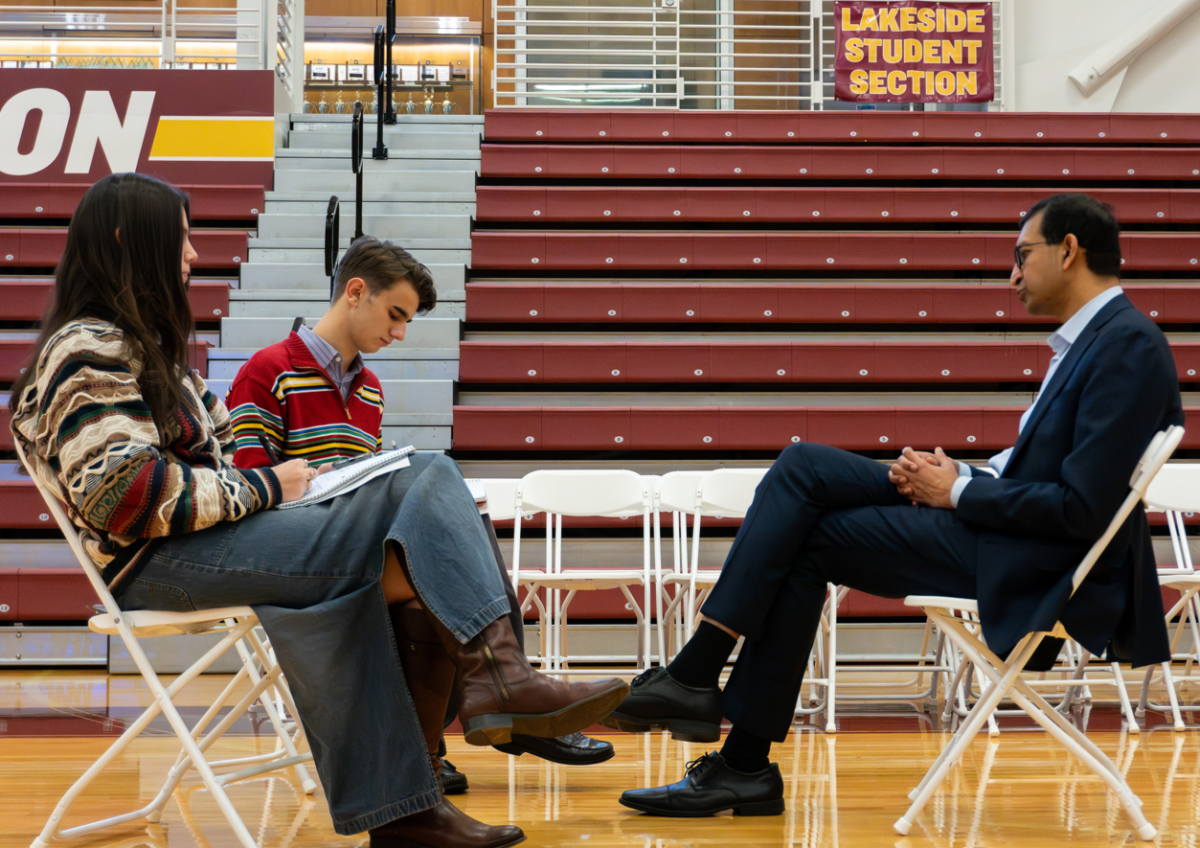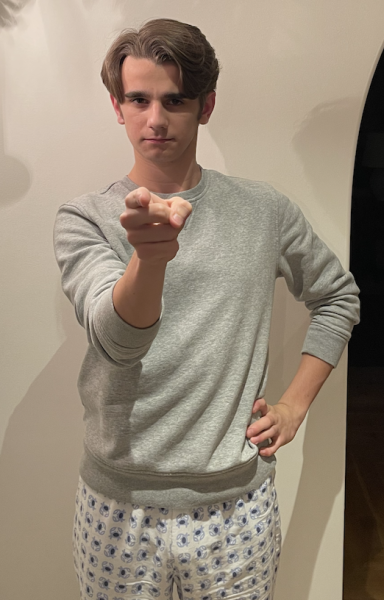On December 18th, 2024, Raj Chetty — the William A. Ackman professor of Public Economics at Harvard University — spoke to Lakeside’s Upper School about the American Dream (framed in terms of relative generational wealth), the opportunity gap that prevents an increasing number of individuals — especially those of certain demographic groups — from realizing that Dream, and remedial measures that he’s explored to potentially address the gap. Evidenced by the swarm of Upper School students who sought Dr. Chetty out after or the audience’s murmurings at several of his graphs, the assembly elicited a fair number of questions and realizations about the modern nature of possibility in the United States. The editors-in-chief of the Lakeside Tatler had the opportunity to sit down with Dr. Chetty for twenty minutes and investigate such wonderings. The details of that interview follow.
Jackson B. ’25 (JB): I wanted to ask about the article that came out about how the Ivy League broke America, in which you are referenced, as well as your 2023 paper on “The Determinants and Causal Effects of Admission to Highly Selective Private Colleges.” It’s noted in both that there is a significant role that the Ivy League and selective colleges play in creating opportunity — I think in the article it’s phrased as kind of a candelabra effect, where funneling into one gives a greater breadth of opportunity for others. And it’s kind of true in your 2024 paper’s point on how parental employment affects child success. It’s also noted in the same article that certain employers are only selecting for certain colleges, so to what extent does the onus for changing opportunities rest on these selective colleges, and to what extent do you believe employers and cultural institutions have their own responsibility to perhaps reconsider the value we’ve placed on the Ivy League?
Raj Chetty (RC): That’s an excellent question. So the facts are that it matters a great deal if you end up attending one of these Ivy League+ institutions or these highly selective colleges where you can basically imagine an apples-to-apples comparison when one kid gets in and one doesn’t. As you noted, there’s a real springboard effect if you get into the Ivy League colleges: you’re much more likely to have a higher income, to attend a top graduate school, to work in a prestigious firm. Down the road we see a huge traction of Senators, Supreme Court Justices, CEOs, etc., coming from these kinds of institutions.
So, there’s no doubt that in the current system, it matters and the point we make in the paper, and it’s related to the David Brooks article you mentioned, is that access to those institutions isn’t equally distributed and then we end up with a perpetuation of privilege with these universities as a key conduit that [is] perpetuating that privilege. Now the question you’re asking is does that mean that the problem can be solved entirely by those institutions, like changing their admissions policies, or is it possible that employers can instead of recruiting — take a firm like Goldman Sachs that recruits a lot of people from the Harvard or Dartmouth campus — should they be casting their net more widely? So I think both approaches make sense. I don’t think our analysis directly speaks to that. My view is that while you could ask employers to change what they do, they’re in the business of trying to maximize profits and there are many different employers. So in effect, one reason employers might screen the way they do is that they’re basically leaning on the colleges to have already done much of this screening and training — it’s very costly to interview everyone at a thousand different college campuses. If you know on average there’s a lot of talent at a selective subset of places, it can be efficient as an employer — and I’m not saying this justifies these practices, it can certainly amplify biases and limit opportunities — but if you just think about it from a profit-maximizing CEO’s perspective, at the end of the day you got to do what your shareholders want. So I think maybe it’s wishful thinking that we’re going to get employers to fundamentally change what they do. In contrast, I do think that colleges have the ability to change their admissions policy. Do we have legacy preferences? What ways do we put out athletics or non-academic factors that are in some ways contributing to these differences? Those are real decisions by admissions offices and we’re actually seeing colleges change what they’re doing. While the point I’m making may be true globally, the practical place to have an effect in the short run is on the college side.
Reagan R. ’25 (RR): On the topic of colleges, I was reading a bit on the idea of “lost Einsteins,” specifically the paper you published “Who Becomes an Inventor in America? The Importance of Exposure to Innovation” arguing that there are many lost Einsteins in the U.S., typically women, minorities, and children from low-income families who could have been innovators should they have had more access to opportunity. I’m wondering to what extent do you think the recent dissolution of affirmative action has shifted the way we think about lost Einsteins and what impact will that have on incoming classes?
RC: Certainly the dissolution of affirmative action has already changed the racial makeup of college campuses, insofar that colleges are a place where people get that exposure. So colleges can further amplify these issues and lead to more lost Einsteins but my view is actually stepping back–while that matters, what we see on the data is that racial and socioeconomic divides emerge well before college applications like access to quality schools like this one, who lives in a neighborhood from a young age where you’re exposed to people who become scientists, where you think about studying, where you think about certain career paths, think about being attached to the labor force. There are enormous differences between race, between income, starting at birth and so my perspective on affirmative action is certainly it matters in terms of the diversity of college campuses — and you can have different views on whether who should have more and less diversity — but the problem starts much, much before. Unless we address those fundamentals and really invest in opportunities in the earlier stages in these under-served communities, I think it’s sort of a band-aid to fix the problem through our college institutions.
JB: Speaking of recent political moves that are in many ways related to opportunity, I wanted to ask about school choice which was something we saw featured a lot in the 2024 elections. At the state level you had measures in Colorado, Kentucky, and Nebraska which all failed, but it does exist here in Washington and in a number of other states. It’s also kind of related to us here at Lakeside because we often think of the differences that exist between our educational opportunities and those of our friends in our public school systems. Do you think school choice measures have a broadly positive or negative effect on improving opportunity, and what ought to be the role of public or private schools relative to one another?
RC: Yeah so I think as with many things, it’s complex where school choice can have a role but I also think it’s important to have investment in public education. So I think the argument for school choice is a traditional market-based argument that if you get people to compete, the people providing the best product — like if you think about making a car or a phone — free market competition is a good way to get people to try and innovate the best possible service. So you would think that logic has some merit in the context of schools that there are certain schools that educate people really well and people figure that out, their schools will grow, their models will expand, their market share will grow. And I think there’s some truth to that. I think the problem is two-fold in making the analogy purely to markets. A) that the outcomes are quite hard to measure. It’s difficult to tell which schools are truly good and which are just cream-skimming in the sense that they’re getting students who would’ve done well anyway and admitting those students and then having really great outcomes, kids go to great colleges, etc., but is that really the value added of the school or just that set of students? So unless you’re really careful about measuring your students, that’s a very tricky thing to do. The second thing is with some of the data is when you have school choice, often it’s the more privileged that end up choosing the schools that are really good and lower-income families, families from minority backgrounds, they end up staying in the schools that are not as good. And that might be because they lack information, they lack systems of getting to those schools because things like proximity end up mattering more for lower-income families who don’t have resources to figure out how to get their kids to a school on the other side of the lake, or whatever it may be. And so we actually see in the data, that while in theory school choice is this mechanism that gives everyone access to better schools, in practice, sometimes it actually ends up amplifying the gaps that it intends to fix. School choice can certainly be part of the picture but we also need to think about how we can strengthen public schools in tandem and how we support people if we have a school choice system in making better choices.
JB: Just quickly on that, what do you think the role between private and public schools should look like in a society that is aiming to increase opportunity?
RC: Private schools clearly create opportunity people otherwise wouldn’t have had. Ideally, you would have resources so that kids from lower-income families would be able to attend some of these private schools for a great education. I think again one has to be very careful in designing that kind of system. If you have a system with vouchers for example, which has been experimented with houses, the concern is that in some cases you get access to schools like this that are producing great outcomes but then other cases we see this very clearly with for-profit college space where people set up for-profit colleges given the incentive to be able to make money but those colleges are not really delivering good outcomes. They’re advertising and getting people to join programs that ultimately don’t have a payout. And I worry that if you really are going to make it market oriented like that, there’s going to be incentives to do that, in the context of high schools.
RR: Remaining on the topic of schools, I’m interested in the idea of social capital as well in which you found that children who had social relations with peers from higher-income families ended up with higher incomes themselves and I understand that in one of your papers you advocated for the use of recreational spaces like churches to establish those relationships. That being said — and I know that socioeconomic divides start way earlier than college — how much responsibility falls upon colleges to manufacture social mobility through diverse classes and at these colleges, how do you mitigate “friendship bias” in a way that doesn’t feel superficial to your institution and to your students?
RC: So colleges as we’ve been discussing have a lot of emphasis on admitting diverse student bodies but have not had as much [emphasis] in terms of integrating those diverse students once they’re on campus. So you’ll see in many colleges, and in many high schools actually, that are diverse on the surface, that they have — you noted friending bias— that people break into different subgroups. And [though] we mentioned the church example and the recreational reason does not necessarily mean that that is the solution. Not everyone wants to participate in a religious organization etc., but more that it’s an illustration that these things are not set in stone. We see the same person making very different friends in their sports group, in their church, relative to the friends they make elsewhere and the point of that is that it must not be that they have a strong preference for making certain types of friends. It apparently depends on the context. So I would take that logic to colleges and say, “Can we create more of those points of commonality for kids of very different backgrounds in a deliberate way that brings people together around specific activities?” Another example is that we found that there’s much less friending bias in small classes than big classes. In big groups, people tend to split apart. In small groups, people tend to come together and interact with kids of different backgrounds. So, can we create smaller cohorts? At Harvard we have an incoming class of 1600 students. Can you chop that up into smaller groups that are diverse that get people to come together? You can see some programs for freshmen that have that sort of feature of creating [a] common identity being like outdoor exploration program that people set up when they come to campus. I think thinking more deliberate ways along those lines rather than having huge lectures are other ways of creating those connections. I basically think colleges can do more to be deliberate about this.
RR: Do you think then it’s harder for bigger institutions to create those smaller class sizes versus a school like Harvard that may have the resources to hire more faculty?
RC: Yes, that’s absolutely right. But it’s not necessarily [something] you have to spend a tremendous amount of money on. At the end of the day, a lot of these things you can innovate if you cast this as a problem you want to solve, just like in the way we’ve started to really focus on diversity in admissions […] This is just not on the radar screen so the first step is to get it on the radar screen.
JB: Speaking on communities, neighborhoods, and childhood intervention, I noticed one of your studies — the CMTO one — actually took place in King County which is super cool to see. I’m interested by the premise of it moving people from low-income zones to higher opportunity zones. It’s no secret that here in Seattle we have neighborhoods that for a variety of factors, like historical neglect and redlining, happen to be low-opportunity and low income. I’m wondering what do you think should be the balance between initiatives like the CMTO one that moves people from low-income zones into higher ones — AND focusing on instead of improving those zones instead of a mass exodus?
RC: That’s a great question and I’ll actually address it in the lecture I’ll give later today where I’ll show both briefly the CMTO data but then previous results form the next paper we’ll be putting out which studies a program called Hope 6 that sought to spend billions of dollars basically revitalizing high poverty housing projects, trying to bring opportunity to those places instead of bringing them to it. And the takeaway you’ll see in these slides is that that program is also quite effective in changing kids’ outcomes with a very high rate of return and my view is that basically we should be doing both. You don’t have to do one at the expense of the other. I think we should give families more choice in terms of where they live and empower them to make the best choices for their kids as we would all want and at the same time work hard to bring opportunity to the places that have been neglected rather than simply trying to move people around, because obviously you can’t move everyone. It’s unscalable. So we’re starting to see in our most recent work that it is actually phasable to change opportunity in a given place and we’re hoping to do more work on that front and do a little more policy intervention on that front.
JB: Do you see that as something being facilitated on the county level, city level, or state level just in terms of scalability?
RC: Yeah, I think it’s very local. So you’ll see this Hope 6 program is literally operating on the neighborhood level, taking these big public housing towers and transforming them into neighborhoods. So here it’s not possible and in that case, it could be the federal government. It could be local cities, it could be counties — I actually think the most creative way to do it would be to harness private capital and the private market and figure out a way to do that. [It’s] something I’ve been thinking about recently because there’s only so much you can do with taxpayer money through the government, but I don’t think we’ve quite figured out how to do it.




